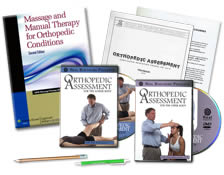30 Hour CE Course

Already own the Orthopedic Assessment DVDs or Massage and Manual Therapy for Orthopedic Conditions text? Call us at 1-800-364-5722, 9am to 5pm, to discuss your enrollment options.
Learn classic assessment techniques for the neck, shoulder, elbow, ankle, knee, hip, spine and more. This course introduces massage techniques for orthopedic conditions, promoting the alignment of soft tissue relating to pain and dysfunction.
For clinical massage therapy, the course text contains brief descriptions of rationale behind orthopedic massage, mechanisms of injury to and repair of soft tissue, and anatomy of each body area.
The accompanying Upper Body and Lower Body course DVDs also provide 3-D animations to show exactly which structures are involved. Each section of the DVDs are divided into Subjective Assessment, Observation, Tests, Special Tests and Palpation, including:
You'll learn specific orthopedic conditions of the human body and discover how various massage therapy techniques can help ease pain and dysfunction of soft tissue. Specific pathologies regarding mobility, posture, injuries and diseases are included as examples of what can be addressed by massage therapists and which conditions are seen as contraindications. Several methods which help to promote proper alignment of soft tissue including wave mobilization, muscle energy technique and joint mobilization are defined, explained and demonstrated in the course materials.
The Orthopedic Assessment program will walk you through a logical progression of testing that will reveal the underlying pathology with crystal clarity.
The techniques and assessment provided in this program are meant to be practiced by licensed healthcare practitioners. Check your local laws to find out if performing these tests is within your scope of practice.
This was a great course. Lots of good muscle review. Plus great assessments for additional adjunct work in the massage field. This course will help me to take my massages to a new level.J. Ridge, NCTMB
This course is very in depth. The manual/book along with the DVD's were very helpful in completing the course. I would recommend this course for the more advanced graduate. I would not recommend this course for the graduate looking to just fulfill CEUs.H. Brooks, LMT
I thoroughly enjoyed this course! Excellent! Thank you for giving me more tools to help others!C. Joseph, LMT, NCTMB
Great course, exceeded my expectations!! Thank you for all of your hard work.William Diederich, CMT, NCTMB
Very informative book. i will be referencing this many timesSabrina Fendel, LMT
This is an awesome course!!!Jill Kramer, LMT, NCTMB
-excellent course material, kept my interest -found the information very applicable -invaluable informationSandra Shepherd
Amazing course! The book and instructional DVD were very easy to follow. I now can target and help clients on a whole new level!!Alyssa Hirschman, LMT
Good material!Kristi Mathis, LMT
This course is great.Sabrina Gautier, LMT, CMT, NCTMB
Great course and book. I learned a lot of valuable information.Samantha Mitchell, LMT, NCTMB
Great way to earn credits at home! thanks a bunch:).Paul Baddoo
The book is an excellent source of invaluable information. The DVD's are as well but every time I sat down to watch I would fall asleep. I think it was because of the background music and the white background setting behind Dr. Edmundson and his demo person. It was just too hypnotic. Different music with maybe a quiet library or classroom setting would help.... At least that is what I thought would hold my attention better. Other wise it was a fantastic course! I found it challenging and very Fascinating! With lots of practice this course will help take my work tonew levels.Alisa Allen, LMT, NCTMB
I appreciated having the DVD's to this course. I suggest otheres taking this course to have taken or have a strong background and understanding of anatomy, physiology, basic biomechanics, and have a background in structural bodywork. This course will take that practitioner to the next level and sharpen his/her skills quicker. In conclusion, having a strong foundation and experience in orthopedic massage prior to this course anchored and added to my work. I have already and will continue to use Thomas Hendrickson book as a strong resrouce.Karen Baskin, LMT, NCTMB
If you love anatomy, be ready for this one. It will bring out the best in you, and the overall treatment plan for your clients.George S. Andrews, LMT
Loved it!! I cant wait to take more courses!Milissa Resnick, LMT
I highly recommend the Institute, I have taken course previously and have been completely satisfied and this course is no exception. Dr. Vodder's Lymphatic Drainage is brilliantly presented, the Manual is Golden and having a DVD as an additional resource is brilliant. Having this invaluable knowledge increases my professional knowledge and will be a great asset to my career. Thank You, Kennette Klees Aesthetician/Massage Therapy Instructor/LMT Reiki Grand MasterKennette Klees, LMT
Massage is about circulation. Retaining a good understanding of lymphatics will help you to create a better awareness to yourself and client while giving massage.George S. Andrews, LMT
The LDM course and materials are excellent. I was able to apply the knowlege immediately on myself with immediate results as I am in a post operative stage.Karen J. Streichert, LMT
The program you offered is great way for me to learn this useful knowledge as I could learn repeatedly until I understand completely. Thank you very much for this programJianyun Wang, LMT
This was the most informative and well laid out material I have study in a long time. I will continue to refer to the information I have learned from this course.Yalanda Patria, LMT, NCTMB
Took longer than expected. Lot of theory.Naman Raina
Great course! A good refresher for anyone needing to brush up!Rita McNeil, NCTMB
My expectation for an online course were fairly low. This class WAY exceeded those expectations!Megan Hamilton, LMT
Really enjoyed taking this course, you essentially get 2 courses in one. You can really go and study all the MET and STM protocols in the manual and add it to your therapy sessions, they are very precise in the writing of every step on how to perform these modalities. The DVD's are full of info and great assessment approach, although the background to them was pure white and it gets to your eyes and gave me a headache after the first DVD and i had to take a break.Myriam Rita Scott, RMT
The videos are course material were very informative and relevant, but I found the test questions significantly less relative to my initial take away information. Although I learned lots of other this in school I would have liked to see more questions focused on how the assessments could alter or enhance our treatment plans. Overall I found this course a great refresher and the actual course material relating MET and soft tissue techniques to various areas and conditions extremely helpful.Alexandra Graham, RMT
The textbook by Hendrickson will be a great reference tool in my practice. The videos (2) with Alan Edmundson, PT, were well done and instructive. His experience gives insight into different conditions and how to access them. The graphic illustrations are well integrated with his instruction and demonstration. I would like to see more videos from him in addressing specific injuries and conditions like rotator cuff injuries, hip and knee replacements, and geriatric falls. Highly recommended course, especially if you are willing to follow the video demos with a willing client on a massage table.Mary C. Edson, LMT


Take our free online course: Ethics Refresher
We will not rent/sell your email to anyone.
You'll also receive our newsletter and special offers.
Thank you! An email will be sent to the address provided with instructions on how to enroll in this 1 CE hour course - FREE!
If you do not see our email within a few minutes of signing up, please check your Spam/Junk folders it may have been delivered there instead of your inbox.
If, by chance, you still have not received it within 5 minutes, please call us at 1-800-364-5722, Monday-Friday, 9am-5pm EST for assistance.